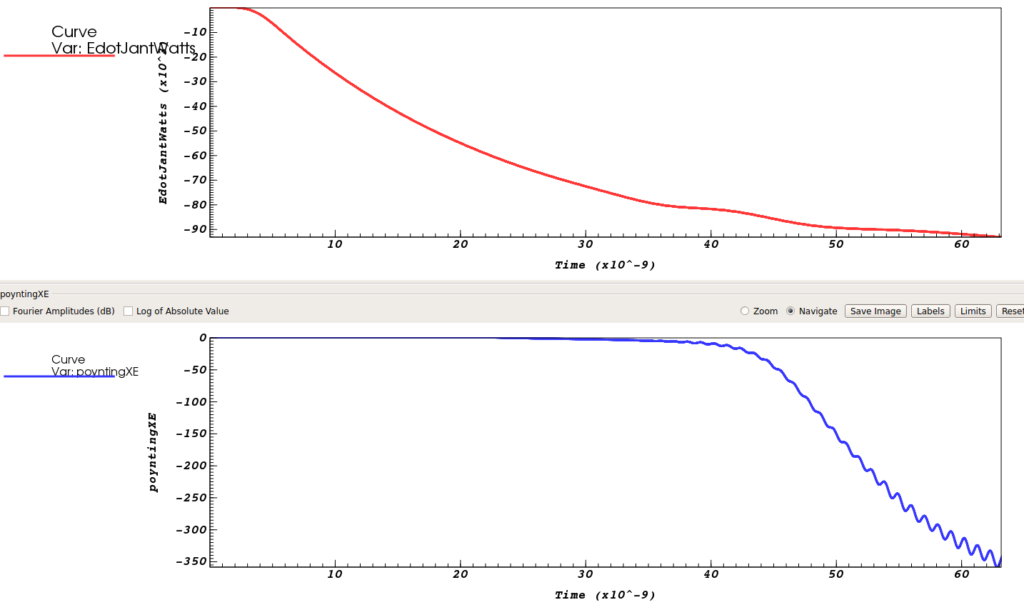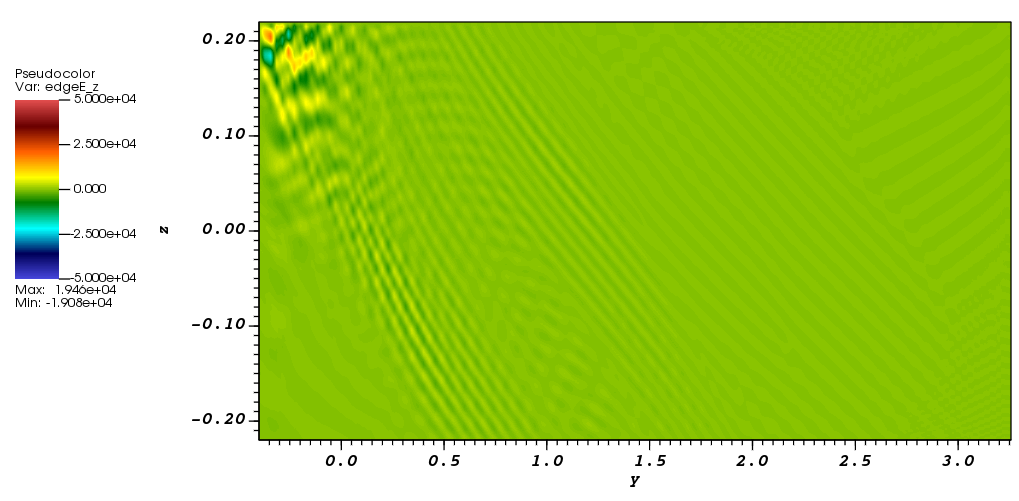Time evolution of temperatures and densities
2dt tesepm tesepi tesepa; electron temperatures at midplane, inner and outer divertors
2dt tisepm tisepi tisepa; ion temperatures at midplane, inner and outer divertors
2dt nesepm nesepi nesepa; electron densities at midplane, inner and outer divertors
Other quantities to plot with 2dt:
fnixip — integrated poloidal particle flux, inboard divertor
feexip — integrated poloidal electron energy flux, inboard divertor
feixip — integrated poloidal ion energy flux, inboard divertor
fetxip — integrated poloidal tot energy flux, inboard divertor
fchxip — integrated poloidal current, inboard divertor
fnixap — integrated poloidal particle flux, outboard divertor
feexap — integrated poloidal electron energy flux, outboard divertor
feixap — integrated poloidal ion energy flux, outboard divertor
fetxap — integrated poloidal tot energy flux, outboard divertor
fchxap — integrated poloidal current, outboard divertor
nesepi — separatrix electron density, inboard divertor
tesepi — separatrix electron temperature, inboard divertor
tisepi — separatrix ion temperature, inboard divertor
tpsepi — separatrix plate temperature, inboard divertor
posepi — separatrix potential, inboard divertor
nesepm — separatrix electron density, outer midplane
tesepm — separatrix electron temperature, outer midplane
tisepm — separatrix ion temperature, outer midplane
posepm — separatrix potential, outer midplane
dnsepm — diffusion coefficient, outer midplane
dpsepm — pressure diffusion coefficient, outer midplane
kesepm — electron thermal diffusivity, outer midplane
kisepm — ion thermal diffusivity, outer midplane
vxsepm — poloidal pinch velocity, outer midplane
vysepm — radial pinch velocity, outer midplane
vssepm — viscosity coefficient, outer midplane
nesepa — separatrix electron density, outboard divertor
tesepa — separatrix electron temperature, outboard divertor
tisepa — separatrix ion temperature, outboard divertor
tpsepa — separatrix plate temperature, outboard divertor
posepa — separatrix potential, outboard divertor\000max
nemxip — maximum electron density, inboard divertor
temxip — maximum electron temperature, inboard divertor
timxip — maximum ion temperature, inboard divertor
tpmxip — maximum plate temperature, inboard divertor
pomxip — maximum potential, inboard divertor
nemxap — maximum electron density, outboard divertor
temxap — maximum electron temperature, outboard divertor
timxap — maximum ion temperature, outboard divertor
tpmxap — maximum plate temperature, outboard divertor
pomxap — maximum potential, outboard divertor
fniyip — integrated radial particle flux, main chamber
feeyip — integrated radial electron energy flux, main chamber
feiyip — integrated radial ion energy flux, main chamber
fetyip — integrated radial tot energy flux, main chamber
fchyip — integrated radial current, main chamber
fniyap — integrated radial particle flux, divertor region
feeyap — integrated radial electron energy flux, divertor region
feiyap — integrated radial ion energy flux, divertor region
fetyap — integrated radial tot energy flux, divertor region
fchyap — integrated radial current, divertor region
pwmxip — maximum total power flux, inboard divertor
pwmxap — maximum total power flux, outboard divertor
tmne — total number of particles
tmte — total electron energy
tmti — total ion energy
tmhacore — H-alpha emissivity, core
tmhasol — H-alpha emissivity, SOL above the x-point
tmhadiv — H-alpha emissivity, divertor region
fnisip — poloidal particle flux, into inboard separatrix throat
feesip — poloidal electron energy flux, into inboard separatrix throat
feisip — poloidal ion energy flux, into inboard separatrix throat
fetsip — poloidal total energy flux, into inboard separatrix throat
fchsip — poloidal current, into inboard separatrix throat
fnisap — poloidal particle flux, into outboard separatrix throat
feesap — poloidal electron energy flux, into outboard separaatrix throa
feisap — poloidal ion energy flux, into outboard separatrix throat
fetsap — poloidal total energy flux, into outboard separatrix throat
fchsap — poloidal current, into outboard separatrix throat
fnisipp — poloidal particle flux, core x-pt region
feesipp — poloidal electron energy flux, core x-pt flux region
feisipp — poloidal ion energy flux, core x-pt flux region
fetsipp — poloidal total energy flux, core x-pt flux region
fchsipp — poloidal current, core x-pt flux region
fnisapp — poloidal particle flux, x-pt private flux region
feesapp — poloidal electron energy flux, x-pt private flux region
feisapp — poloidal ion energy flux, x-pt private flux region
fetsapp — poloidal total energy flux, x-pt private flux region
fchsapp — poloidal current, x-pt private flux region
fn3dl — poloidal main species flux, inboard divertor
fe3dl — poloidal electron energy flux, inboard divertor
fi3dl — poloidal ion energy flux, inboard divertor
ft3dl — poloidal total energy flux, inboard divertor
fc3dl — poloidal current, inboard divertor
fl3dl — poloidal electron flux, inboard divertor
fo3dl — poloidal ion flux, inboard divertor
ne3dl — electron density, inboard divertor
te3dl — electron temperature, inboard divertor
ti3dl — ion temperature, inboard divertor
po3dl — potential, inboard diverto
an3dl — atom density, inboard divertor
mn3dl — molecule density, inboard divertor
tp3dl — plate temperature, inboard divertor
ne3di — electron density, inboard midplane
te3di — electron temperature, inboard midplane
ti3di — ion temperature, inboard midplane
po3di — potential, inboard midplane
an3di — atom density, inboard midplane
mn3di — molecule density, inboard midplane
dn3di — diffusion coefficient, inboard midplane
dp3di — pressure diffusion coefficient, inboard midplane
lh3di — radial neutral heat flux limiter, inboard midplane
ln3di — radial neutral part flux limiter, inboard midplane
ke3di — electron thermal diffusivity, inboard midplane
ki3di — ion thermal diffusivity, inboard midplane
vx3di — poloidal pinch velocity, inboard midplane
vy3di — radial pinch velocity, inboard midplane
vs3di — viscosity coefficient, inboard midplane
ne3da — electron density, outboard midplane
te3da — electron temperature, outboard midplane
ti3da — ion temperature, outboard midplane
po3da — potential, outboard midplane
an3da — atom density, outboard midplane
mn3da — molecule density, outboard midplane
dn3da — diffusion coefficient, outboard midplane
dp3da — pressure diffusion coefficient, outboard midplane
lh3da — radial neutral heat flux limiter, outboard midplane
ln3da — radial neutral part flux limiter, outboard midplane
ke3da — electron thermal diffusivity, outboard midplane
ki3da — ion thermal diffusivity, outboard midplane
vx3da — poloidal pinch velocity, outboard midplane
vy3da — radial pinch velocity, outboard midplane
vs3da — viscosity coefficient, outboard midplane
ne3dr — electron density, outboard divertor
te3dr — electron temperature, outboard divertor
ti3dr — ion temperature, outboard divertor
po3dr — potential, outboard divertor
an3dr — atom density, outboard divertor
mn3dr — molecule density, outboard divertor
fn3dr — poloidal main species flux, outboard divertor
fe3dr — poloidal electron energy flux, outboard divertor
fi3dr — poloidal ion energy flux, outboard divertor
ft3dr — poloidal total energy flux, outboard divertor
fc3dr — poloidal current, outboard divertor
fl3dr — poloidal electron flux, outboard divertor
fo3dr — poloidal ion flux, outboard divertor
tp3dr — plate temperature, outboard divertor
It possible to use arguments -ly for log scale.
The density profiles and the plasma equilibrium are not evolved in our TRANSP simulations of the DIII-D discharge 164410. Any experimental uncertainties for these two quantities can affect the predicted electron and ion temperature profiles. The experimental q and ne profiles at the times of interest are given below.

The electron density profiles at 4.1 sec (dashed curve) and 5.01 sec (solid curve).

The q profiles at 4.1 sec (dashed curve) and 5.01 sec (solid curve).
In order to test the effect of experimental density and q- profiles on the predicted temperature profiles, the U-files for density and q-profiles have been modified. In particular, in the simulation 164510T11 the q-profile from 3.5 sec to 5.1 sec is set to the experimental profile at 4.1 sec. In the simulation 164510T15, the q-profile from 3.5 sec to 5.01 sec is set to the experimental profile at 5.01 sec. In the first simulation, the agreement between experimental and predicted profile at 5.01 sec is examined. In the second simulation, the agreement at 4.1 sec is examined.
Use of the experimental q-profile at 5.01 as a constant profile from 3.5 sec to 5.1 sec, made the agreement with the experimental data better at 4.1 sec:


Use of the experimental q-profile at 4.1 as a constant profile from 3.5 sec to 5.01, made the agreement with the experimental data worth at 5.01 sec:


Similar study with the plasma density profiles (simulations 164510T12 and 164510T14) show a relatively weak dependence on the plasma density profiles.
The DIII-D discharge 164510 is a high plasma current discharge with two times of interest at t=4.1 sec with the plasma current 0.9 MA and at t=5.01 sec with the plasma current 1.05 MA.
The MMM7.1 model in the TRANSP code has been used to model this discharge. At both times, the electron and ion temperatures are found to be under-predicted. The MMM7.1 has also failed to reproduce the internal transport barrier observed in the ion channel of transport.

The electron temperature profile at 4.1 sec predicted with the MMM7.1 model (solid curve) and experimental profile (dashed curve).

The ion temperature profile at 4.1 sec predicted with the MMM7.1 model (solid curve) and experimental profile (dashed curve).

The electron temperature profile at 5.01 sec predicted with the MMM7.1 model (solid curve) and experimental profile (dashed curve)

The ion temperature profile at 5.01 sec predicted with the MMM7.1 model (solid curve) and experimental profile (dashed curve).
There is a strong ion thermal transport driven by ion temperature gradient modes at both times of interest:

Ion thermal diffusivities at 4.1 sec (solid curve) and 5.01 sec (dashed curve).
The electron thermal transport is smaller than the ion thermal transport.

Electron thermal diffusivities from Weiland component of MMM7.1 at 4.1 sec (solid curve) and 5.01 sec (dashed curve).
The contribution from the ETG component is also relatively small and does not change much between two times of interest.

Electron thermal diffusivities from the ETG component at 4.1 sec (solid curve) and 5.01 sec (dashed curve).
It is likely that the model over-predict the ion thermal transport driven by ITG modes in this plasma parameter regime.
The Shafranov shift effect is included through a geometric factor modifying the ion magnetic drift frequency, which varies strongly around each magnetic surface:

j is the ion specie index, Z is the ion charge,  is the wave vector in the poloidal direction, s is the magnetic shear, and
is the wave vector in the poloidal direction, s is the magnetic shear, and  is the alpha MHD which is defined as
is the alpha MHD which is defined as
 .
.
The alpha MHD is proportional to the Shafranov shift and the effect of the Shafranov shift can be investigated by introducing a scaling factor for the last term in the first equation above:
 .
.
The coefficient  is added to the PTRANSP namelist. Five values of
is added to the PTRANSP namelist. Five values of  are tested:
are tested:
 – simulation 154406A51 (dashed curve with triangles)
– simulation 154406A51 (dashed curve with triangles)
 – simulation 154406A52 (dash-dotted curve with crosses)
– simulation 154406A52 (dash-dotted curve with crosses)
 – simulation 154406A30 (solid curve with circles)
– simulation 154406A30 (solid curve with circles)
 – simulation 154406A53 (dashed curve with squares)
– simulation 154406A53 (dashed curve with squares)
 – simulation 154406A54 (dashed curve with circles)
– simulation 154406A54 (dashed curve with circles)


The predicted electron (left) and ion (right) temperature profiles.


Electron (left) and ion (right) thermal diffusivity profiles computed using the Weiland component of MMM7.1.
The Shafranov shift has stabilizing effect on electron and ion channels of transport. However, the effect on the electron channel is somewhat weaker. Also, the large spike in transport in the ITB region in the electron thermal diffusivities is found weakly affected by the Shafranov shift.






































